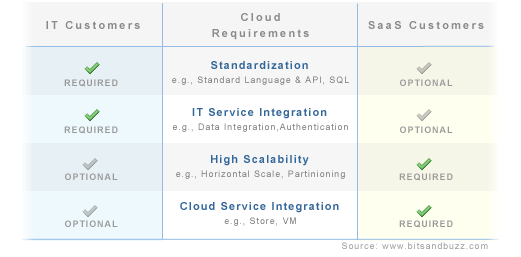Enterprise Cloud: IT vs SaaS
September 16th, 2009 by jeremychoneNow that we have established that cloud computing is a real phenomenon that provides real technological and business value, the next question is how does it apply to the enterprise market?
To fully analyze this market opportunity, we need to realize that there are two related but different types of enterprise customers for cloud computing.
The first type is internal information technology (IT) organizations within the enterprise that are looking for more agile and cost-effective ways to manage their Internet application and services. The second type is the enterprise SaaS providers who want to leverage proven, highly-scalable architectures and integrate them into some cloud applications to increase functionality and maximize distribution.
IT and SaaS cloud customers have similar requirements but different priorities.
Here is a high-level view of some of the differences.

1) IT Customers
As discussed in the Enterprise vs Consumer Web article, one of the biggest challenges for enterprise IT is to standardize technological architecture and best practices across their application portfolios to minimize application development and maintenance costs.
Consequently, enterprise IT requires the cloud service to be as standard as possible so that applications, services, and libraries can be easily ported in and out of the cloud without requiring any application rewrite (a.k.a Application Portability). Thus, enterprise clouds must support standard enterprise languages (i.e., Java and/or .Net), a common framework (e.g., Spring, J2EE, Hibernate, and Struts), as well as system and application interfaces (e.g., SOA, XML-RPC, REST, SQL, Monitoring & Management interfaces).
The other important set of requirements from an IT standpoint is service integration. Enterprise software is never about all-or-nothing but rather about mixed environments and perpetual coexistence. Enterprise clouds must, therefore, provide rich service integration capabilities at the data and service layers.
From a cloud platform point of view, Google App Engine comes very close to meeting both of these requirements. Google App Engine data connector apis and fully supports Java. The biggest limitation, at this point, is the lack of support for the SQL interface and, consequently, any object relational mapping libraries, such as Hibernate.
2) SaaS Customers
While Enterprise SaaS customers would welcome the IT cloud features, their primary concerns have to do with scalability and cloud application integration.
The elasticity characteristic of cloud computing is particularly interesting to the SaaS companies since it provides a cost-effective way to scale multi-tenant applications. By choosing a platform cloud solution, SaaS developers do not have to worry about architecting a highly-scalable system as it is a core function of the platform.
The other key advantage of cloud computing for an SaaS business is the cloud application ecosystem. Saas applications can provide greater value-added services by integrating with the cloud applications. And, more importantly, the SaaS business can leverage the cloud applications community as a distribution channel.
So here you have it: one market and two different customer types. If you are an enterprise cloud provider, the trick is to realize the different needs of each customer type and plan a strategy to ultimately satisfy both. If you are a customer, then know what you need and don’t let people tell you what you want.
If you liked this article a +1 on HN or a re-tweet are greatly appreciated. (see R-Tweets)